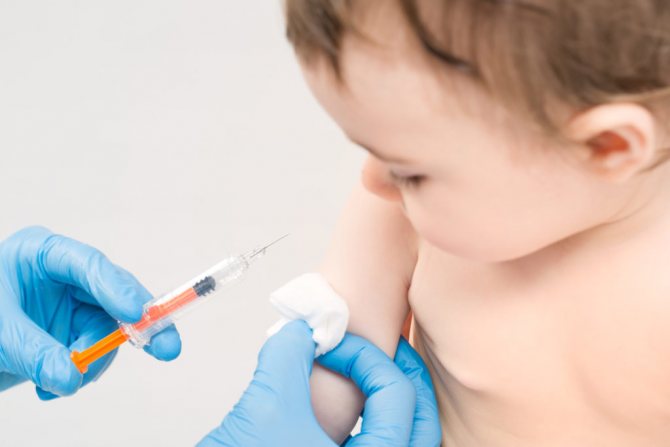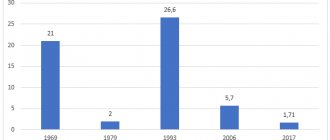“What is the flu? It’s almost like ARVI, children tolerate it easily, but vaccinations cause only harm,” parents argue and write another refusal to vaccinate. Skepticism about the vaccine is often associated with the need to use it annually and poor public awareness of the dangers and complications of the infection itself. Do not forget that children aged from six months to 6 years are at risk - their disease is more severe and the likelihood of complications is high. Vaccination against influenza for a child is the only way of specific prevention. Most drugs are well tolerated and can be administered on the same day as other vaccines.
What is seasonal flu and is it dangerous?
Seasonal influenza is an infectious disease caused by a small enveloped virus. It occurs with primary damage to the respiratory system. After illness, a person develops immunity, but it cannot protect him from all the flu viruses on the planet.
The virus is covered with a shell, inside which contains fragmented RNA - the carrier of genetic information. “Data reading” and protein synthesis are carried out from each “piece” separately. This is the reason for the variability of the virus.
Various protein-carbohydrate complexes are present on the surface of the shell. Two compounds play the greatest importance in the development of the infectious process and the formation of immunity - hemagglutinin and neuraminidase.
Hemagglutinin is a substance that finds receptors on host cells and attaches to them. There are 18 known subtypes of this antigen. Neuraminidase performs two functions: it helps the virus penetrate the epithelial cells of the respiratory tract, dissolving the protective mucous barrier, and “releases” new copies of the pathogen from the host cells, thereby facilitating its spread in the body. Scientists say there are 11 subtypes of neurominidase.
After the meeting, the human body produces antibodies to these antigens, which protect against recurrent disease.
There are 4 types of virus: A, B, C, D. The first two types cause diseases in humans. Influenza A is the most numerous, its representatives cause epidemics and pandemics. The most well-known and relevant representatives: H3N2 and H1N1. Influenza type B is divided into 2 lines - Yamagata and Victoria. Immunity after illness develops only to the strain that caused the infection and lasts up to 3 years for influenza type A and up to 6 years for influenza type B.
Symptoms and complications of influenza in children
The typical clinical picture is characterized by severe intoxication and catarrhal symptoms in the upper respiratory tract. The disease develops acutely, the temperature quickly reaches 38-40 degrees, complaints appear about:
- weakness;
- chills;
- headache;
- joint and muscle pain;
- cough; runny nose;
- nausea, vomiting;
- lack of appetite.
Severe intoxication leads to the fact that the child literally does not get out of bed and sweats profusely. Infants refuse to breastfeed and spit up profusely. There may be disturbances in sleep and wakefulness - excessive drowsiness or agitation. Immaturity of the nervous system leads to the development of febrile seizures.
The influenza virus not only affects the epithelium of the respiratory system. It disrupts microcirculation in the lungs and brain. A number of children develop viral pneumonia and swelling of the brain with symptoms resembling meningitis.
A lightning-fast course is possible, in which the child’s condition begins to deteriorate “before our eyes”, requiring urgent hospitalization in a hospital. The famous pediatrician E. O. Komarovsky, speaking about the need to prevent the disease, emphasized that for children under 6 years of age, influenza is considered one of the most dangerous diseases. The most severe complication in this group is considered to be viral encephalitis. This disease can cause disability or death of the baby.
But other complications also pose a danger to babies and older children. When doubting whether their child should be vaccinated against the flu, parents do not always imagine what a “banal acute respiratory infection” could turn out to be. The most common complications include:
- viral or viral-bacterial pneumonia;
- otitis;
- sinusitis;
- myocarditis;
- meningitis;
- laryngotracheitis with the development of false croup;
- rheumatoid arthritis.
How dangerous is the flu?
Influenza is a viral disease that spreads rapidly among people. This contagious pathology can spread very quickly:
- from an infected person to a healthy person with particles of his saliva, nasal discharge, exhaled breath;
- by touching objects of public use (transport handrails, door handles, elevator buttons), where they can remain for quite a long time, even if the subject who touched them has long left this place.
A carrier of the influenza virus will not necessarily have external signs of infection; the disease may be in the incubation period of its development, without manifesting itself in any way, and the person will already be infectious to others.
The flu has many severe manifestations, it begins with elevated thermometer readings, and gradually signs of intoxication join them. Characteristic symptoms of a viral infection appear on days 2-3 of illness:
- headache, muscle, joint pain;
- feeling of aching bones;
- dizziness;
- chills;
- cough;
- a sore throat;
- nasal congestion and runny nose.
Pediatricians warn that the flu itself is not so dangerous as the complications that this virus provokes. Most often, children suffer from bacterial pathologies such as pneumonia, inflammation of the heart muscle, otitis media, tonsillitis, bronchitis, and sinusitis. Among other things, this infection can seriously aggravate the course of chronic pathologies already present in the patient.
Pneumonia that develops after a viral infection is especially dangerous. It can be quite difficult to get rid of it even in a hospital setting.
Most often, complications during influenza, as well as bacterial consequences, develop in the following categories of patients:
- children under two years of age;
- people with chronic pathologies of the cardiovascular and respiratory systems;
- patients with diseases of the kidneys, liver, endocrine system.
Children attending preschool and school educational institutions have a high risk of contracting this disease. Only a set of measures to comply with preventive rules, as well as timely immunization against influenza, can protect them from infection.
Why vaccination should be done every year
The flu shot helps produce antibodies against virus antigens. Their synthesis is associated with blood cells - B-lymphocytes. The lifespan of populations ready to protect the body from the virus does not exceed 3-6 years. But it often turns out that after 1-2 years, the antibodies produced at the cost of the disease do not work. Why, do they change somehow?
No, flu antibodies in the human body remain the same. This “cunning” virus, mutating, updates its antigenic composition and becomes “too tough” for the human immune system. Therefore, international influenza research centers monitor cases of the disease all year round and analyze strains isolated from people. Based on the information received, WHO experts in the spring of each year name all current variants of the pathogen and write recommendations on the composition of the vaccine for the season.
Rospotrebnadzor warns that the vaccine protects the child from 6 to 12 months and indicates that this period depends on the vaccine itself.
Flu vaccinations for children
Only two types of medications are allowed to be used for infants: Influvac and Grippol.
The Influvac vaccine was created specifically for children. It contains an antigen. The medicine does an excellent job of cleaning the components of the virus in the child’s body.

Influenza is the most effective vaccine for infants to prevent influenza
The Grippol vaccination for infants against the influenza virus has positive reviews. This drug is used most often because it does not cause complications for a healthy newborn. The medicine has a certificate of quality and effectiveness. This remedy develops rapid immunity, so it is allowed at the beginning of an epidemic.
Which flu vaccine is best tolerated by a child?
When choosing a seasonal flu vaccine, parents are looking for a drug that is easily tolerated, does not cause allergic reactions, and actually protects the child from the disease.
There are 4 groups of vaccines registered in the Russian Federation:
- Whole virion. Vaccines contain not destroyed, but neutralized influenza viruses. They are effective and approved for immunization of children over 3 years of age. However, the drugs have not been widely used due to the high risk of allergic reactions.
- Split vaccines. Contains internal and envelope influenza antigens.
- Subunit. Vaccine components: hemagglutinin, neuraminidase.
- Virosomal. It contains unique formations that replicate the influenza virus, with active components - surface proteins, lipids and antigens. The drug is recognized as effective and safe, but is not yet used for mass vaccination.
Protein molecules are “responsible” for allergic reactions: the larger their size, the higher the likelihood that the child will have such an undesirable reaction. Therefore, only subunit or split vaccines are used in pediatric practice.
How to choose the right time for vaccination
WHO experts warn that the incidence of seasonal flu begins to increase as the average daily air temperature drops to 3-5 degrees. At the same time, children are already going to school and preschool institutions after the summer holidays. Dry indoor air and crowded conditions create favorable conditions for the spread of the virus.
This means that by October children should be “prepared” for the new season. According to clinical studies, immunity after vaccination is formed within 2-4 weeks. Therefore, the first half of September is considered the optimal time for flu vaccination at school or kindergarten.
For children under 3 years of age, the vaccine is administered twice, using half the dose each time. The interval between vaccinations should be at least 28 days. You can start as early as August.
When answering the question at what age is it permissible to vaccinate a child, pediatricians recommend carrying out the first scheduled vaccination before the age of one year - from 6 months. Detailed information about restrictions is contained in the instructions for the drug.
Sometimes the annual flu vaccination overlaps with other routine vaccinations. Subunit and split preparations can be administered on the same day as other inactivated vaccines. For example, pediatricians advise combining a flu shot with a pneumococcal or Hib vaccine. This measure helps protect the baby: in their reviews, parents say that thanks to a set of vaccinations, the child has actually become less likely to get ARVI, the diseases are easier and without serious complications.
What do you need to know before vaccination?
Flu vaccination has long been overgrown with many myths that people mistake for true information. For example, some people refuse vaccination due to the fact that negative reactions may occur after vaccination. But few people know that the reason for this may be the person’s ill health at the time of immunization, or improper storage of the vaccine.
Basic rules of vaccination:
- children under the age of three, or those who are vaccinated for the first time, receive the vaccine in two stages, with a break between them of 2-4 weeks;
- The optimal time for vaccination is considered to be autumn (September-October): the development of active immune protection requires at least 4 weeks, which must pass before the seasonal rise in the incidence of ARVI. Late introduction of the vaccine (December, January) will not give immunity time to fully develop;
- Whether to vaccinate a child who attends a preschool institution, a decision must be made only in accordance with the opinion of the other parents of the pupils in the group. If the majority does not get the vaccine, then, already a week after vaccination, these babies can infect those who were vaccinated due to the temporary weakness of their immunity;
- For school-age children, immunization is easier, so you should not refuse it (when there are no other contraindications);
- if you decide to vaccinate your child, care should be taken to vaccinate all family members to reduce the risk of contracting ARVI;
- After vaccination, you should not visit places where many people go for three days. This period is accompanied by a decrease in the body’s defenses, which creates a real threat to contracting a viral infection;
- It is quite possible to get sick after a flu shot; this may be due to the characteristics of your own immunity, the high probability of contracting ARVI while in public places.
The flu vaccine is a colorless liquid, packaged in ampoules or in disposable syringes. The drug can be stored for no more than 12 months, provided that the rules for preserving the drug are followed.
The composition of the vaccine is updated annually to add new strains of influenza, which may be especially common this season.
For children aged 6 months to 3 years, the drug is administered twice with a dose of 0.25 ml in the area of the front of the thigh. After three years, the drug is administered once, the dose is 0.5 ml. The injection is made under the skin into the deltoid muscle, or intramuscularly.
We recommend reading: Viferon gel
Side effects of flu vaccines
The low reactogenicity and high safety of most modern drugs does not mean that flu vaccinations do not have any undesirable effects on the body of children. The most common symptoms include:
- swelling, swelling and redness at the injection site;
- increased fatigue, headaches;
- temperature rise to 37-38 degrees.
These symptoms can be observed for 3 days, go away on their own and do not require seeing a doctor. Allergic reactions occur rarely. They are associated with individual intolerance to the components of the drug; they cannot be predicted.
Contraindications to vaccination
The list of contraindications for children is not fundamentally different from those for adult patients. They are divided into absolute and temporary. The first group includes:
- age up to 6 months;
- allergy to chicken egg white and other components;
- pronounced individual reactions during the previous administration.
Temporary contraindications are associated with changes in the patient’s condition:
- fever;
- acute respiratory diseases;
- decompensation of chronic diseases;
- 2-4 weeks after infectious diseases.
Well, and most importantly, you must know which vaccine your child will be vaccinated with.
If in 2000 the majority of children were vaccinated against influenza for the first time (93.5%), then in 2005 57.5% of children were vaccinated again. Ask your pediatrician how effective a particular vaccine is, how easily the child’s body copes with the chosen drug, what are the possible complications .
Act according to the principle: forewarned is forearmed. For your peace of mind, doctors at the National Center for Children's Health conducted a study of the possible consequences of vaccinations for healthy children and children with chronic diseases, and as a result found that neither the frequency nor the severity of local vaccination reactions differed, and in 88.5% of vaccinated children the level protective antibodies persist for a year. In any case, the infection is more dangerous for children than the possible consequences of properly administered vaccination.
How to choose a vaccine and vaccination time: advice from pediatricians
When listing the pros and cons of various drugs, pediatricians recommend paying attention to the composition and manufacturer of the vaccines. According to WHO recommendations, vaccines that contain 15 micrograms of each strain that is relevant in a given season can be considered quite effective.
The standard volume of vaccine in an ampoule is 0.5 ml. Children under 3 years of age are vaccinated twice with a half dose. This usually happens like this: the nurse draws the required amount of the drug from the bottle, administers the recommended dose, and throws away the unused portion. Modern vaccinations have a convenient form of release for children from six months to 3 years: disposable syringe pens with a ready-made vaccine volume of 0.25 ml.
Should I worry if a child under 3 years of age is injected with a full dose of the drug? Pediatricians refer to the fact that in the national guidelines of some countries it is recommended to administer 0.5 ml to young children and that positive experience has already been accumulated. Doctors emphasize that no serious consequences were recorded. But any first administration of the vaccine occurs twice: even if the baby was first given a full dose, then after a month, according to the rules, 0.25 ml will need to be added.
Children with chronic and oncological diseases (including hematological oncology) are at risk. Pediatricians recommend vaccinating them first.
What should you do if your child missed vaccinations in kindergarten due to health reasons and the optimal time for vaccination has already been missed? Pediatricians recommend waiting 14 days after an acute illness and administering the vaccine. The flu season lasts from October to May; it is better to give the injection somewhat late than to leave the child unprotected.
Refusals to vaccinate are often due to the fact that parents “do not believe” that the vaccine offered by the doctor will actually contain the current strains of influenza. Up to 10 variants of the virus circulate in the human population every year. The vaccine is produced only for 1 season and usually “covers” 2-3 of the most common and pathogenic viruses. Therefore, parents do not have to worry that their child will be given “last year’s” vaccination or that doctors will “mistake” the antigenic composition of the new drug.
Parents are often skeptical about mass vaccinations in schools and kindergartens. They do not trust medical workers and either write a refusal to get vaccinated or go to medical institutions on their own and choose the vaccine that seems most effective to them. Pediatricians do not object to vaccination at a time when the child is truly healthy and parents can observe him before and after the administration of the drug. Doctors also warn that representatives of a minor have the right to issue a written refusal to be vaccinated. Lack of vaccination cannot be grounds for a ban on attending a school or preschool educational institution.
Which children are required to be vaccinated against influenza?

All parents have the right to independently determine the need and possibility of immunization for their children. They must understand that by their own decision they determine the likelihood of their own child becoming infected.
You should not decide on your own to refuse vaccination; it is preferable to consult a specialist (for example, a pediatrician) who will explain all controversial issues in relation to a particular child.
According to the recommendations of experts, it is necessary to get the following vaccinations:
- babies after six months;
- children who often suffer from ARVI;
- children with chronic pathologies (when such a procedure is permitted by a specialized specialist);
- children with immunodeficiency (acquired, congenital);
- patients with pathologies of the respiratory, cardiovascular, urinary, and endocrine systems.
Influenza viruses have the most negative impact on all foci of existing pathology in the body, so children with existing disorders are in greater need of vaccination than others.
How effective is the flu vaccine?
Some parents avoid vaccination, citing the fact that even after vaccination, the child “catch” the virus and can get the flu up to several times during the winter. But the likelihood that your baby will actually get the flu twice in a season is low. The disease immediately after vaccination or after some time may indicate that:
- at the time of vaccine administration, the child was already infected with another ARVI pathogen (incubation period);
- the child subsequently became infected with any other virus;
- the vaccine was administered incorrectly or was stored in inappropriate conditions.
The flu vaccine does not “kill” the immune system and does not increase the likelihood of developing other acute respiratory viral infections. WHO experts note that:
- Vaccination in children under 5 years of age reduces the incidence of confirmed cases of influenza by 87%;
- in preschool children, vaccinations significantly reduce the risk of acute otitis media;
- Vaccines are well tolerated even in children under 1 year of age.
Weighing all the pros and cons of vaccinations, pediatricians agree that vaccination does not really provide a 100% guarantee that the child will not get sick, but it can reduce the risk of complications, the frequency of hospitalizations and the likelihood of infecting other family members.
Vaccination method
Infection can be prevented by vaccination, which is considered the most effective way to protect against influenza.
Rules for administering the vaccine:
- the drug is administered intramuscularly: the muscles are highly mobile, due to which the vaccine quickly and easily spreads throughout all tissues and fluids of the human body. There are many lymphatic and blood vessels located here, which accelerates the spread of the drug;
- the area of vaccine administration is the front surface of the thigh - the quadriceps muscle (in children), the upper part of the forearm - the deltoid muscle (in adult patients);
- the gluteal muscle is not suitable for administration of this vaccine, because a high percentage of adipose tissue will not allow the medicine to pass into the muscle, which will reduce the effectiveness of the pharmaceutical;
- Previously, the graft was given under the shoulder blade, but this area was extremely painful, so this practice was abandoned.










